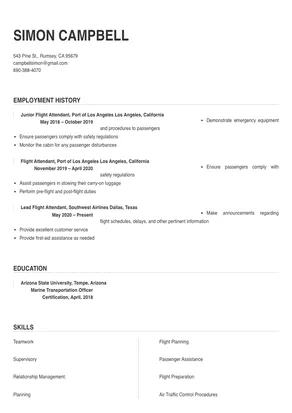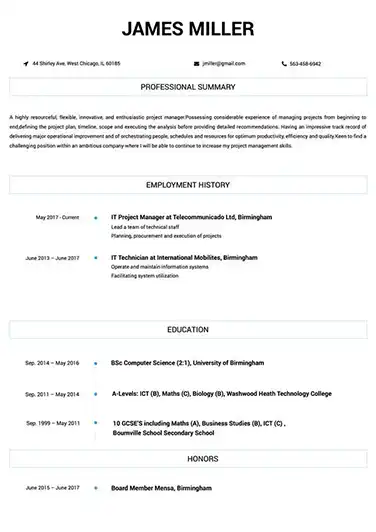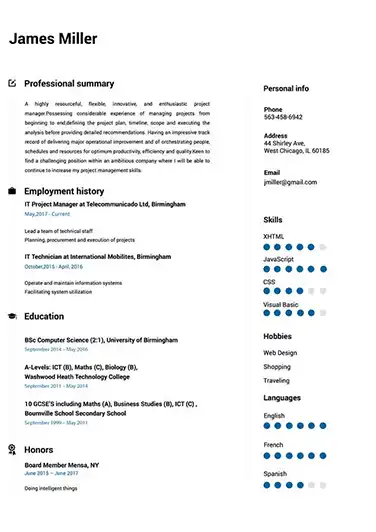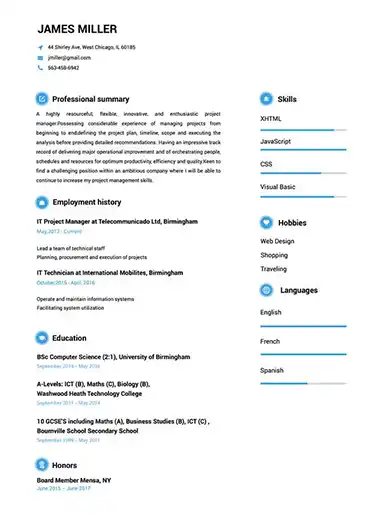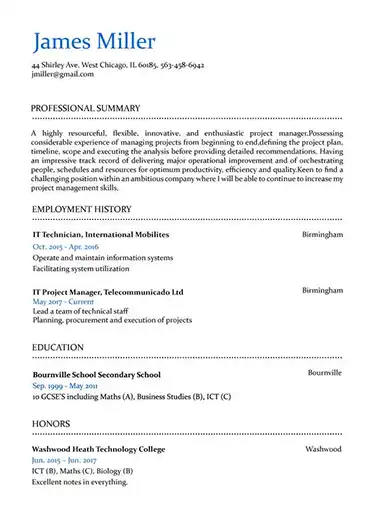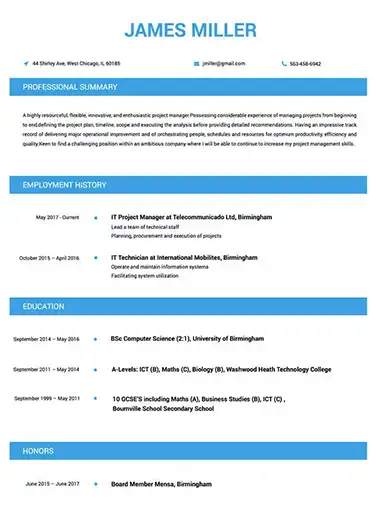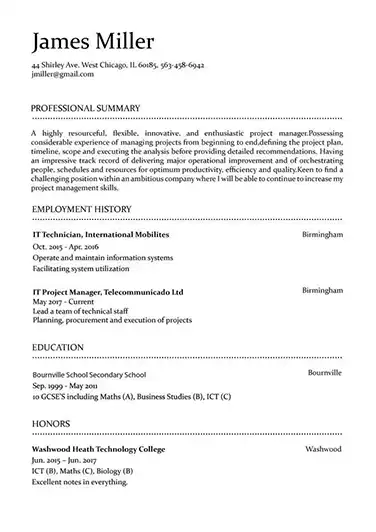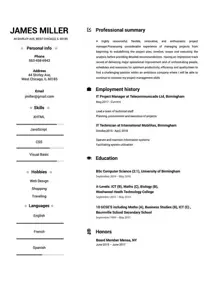 Use This Template
Use This Template
Build your resume in 15 minutes
Create an awesome resume that meets the expectations of potential employers with our selection of professional, field-tested resume templates.
flight attendant: Resume Samples & Writing Guide
campbellsimon@gmail.com
690-388-4070
Employment history
- Make announcements regarding flight schedules, delays, and other pertinent information
- Provide excellent customer service
- Provide first-aid assistance as needed
- Ensure passengers comply with safety regulations
- Assist passengers in stowing their carry-on luggage
- Perform pre-flight and post-flight duties
- Demonstrate emergency equipment and procedures to passengers
- Ensure passengers comply with safety regulations
- Monitor the cabin for any passenger disturbances
Education
Skills
Do you already have a resume? Use our PDF converter and edit your resume.
jake.white@inbox.com
976-314-0763
Employment history
- Collect payment for onboard purchases
- Ensure passengers comply with safety regulations
- Make announcements regarding flight schedules, delays, and other pertinent information
- Assist passengers in stowing their carry-on luggage
- Monitor the cabin for any passenger disturbances
- Provide excellent customer service
- Ensure passengers comply with safety regulations
- Complete paperwork, including flight reports and passenger manifests
- Perform pre-flight and post-flight duties
Education
Skills
andrewellis@aol.com
857-394-0259
Professional Summary
Employment history
- Collect payment for onboard purchases
- Complete paperwork, including flight reports and passenger manifests
- Respond to passenger inquiries and provide information about the flight
- Provide passengers with pillows, blankets, and headsets
- Demonstrate emergency equipment and procedures to passengers
- Ensure the safety and comfort of passengers
- Perform pre-flight and post-flight duties
- Make announcements regarding flight schedules, delays, and other pertinent information
- Assist passengers in stowing their carry-on luggage
Education
Skills
cecildavis49@protonmail.com
760-580-3256
Professional Summary
Employment history
- Verify passenger identification and tickets
- Provide passengers with pillows, blankets, and headsets
- Ensure passengers comply with safety regulations
- Ensure the safety and comfort of passengers
- Ensure passengers comply with safety regulations
- Perform pre-flight and post-flight duties
- Demonstrate emergency equipment and procedures to passengers
- Collect payment for onboard purchases
- Perform pre-flight and post-flight duties
Education
Skills
evansrichard47@icloud.com
813-217-8335
Employment history
- Make announcements regarding flight schedules, delays, and other pertinent information
- Demonstrate emergency equipment and procedures to passengers
- Collect payment for onboard purchases
- Provide first-aid assistance as needed
- Assist passengers in stowing their carry-on luggage
- Ensure passengers comply with safety regulations
- Prepare and serve meals and beverages
- Demonstrate emergency equipment and procedures to passengers
- Ensure passengers comply with safety regulations
Education
Skills
Not in love with this template? Browse our full library of resume templates
Traveling for a living is many people’s idea of a dream job. It’s no wonder that many people glamorize the work of flight attendants. Not only do they get the chance to visit new cities and countries on the company dollar, but they also get to meet passengers from all around the world.
There’s no doubt numerous perks that this career offers. However, any flight attendant will tell you that there are constant challenges to deal with too - all of which must be done with a smile on your face. Rude passengers, turbulence, and delays are just some of the trickier parts of this occupation. And let’s not forget that you’re at every passenger’s beck and call for the duration of the flight.
In addition to all of the challenges flight attendants face in the air, they face one of their most formidable ones back down on earth: getting their dream job. If you’re a flight attendant who’s looking for a promotion within your current airline or you’re looking to switch to a new airline company altogether, you’ll know how competitive the entire hiring process is.
In order to catch a recruiter’s attention, you will need to apply with an eye-catching flight attendant resume that puts your best foot forward.
If you’re unsure about how to piece one together, this guide has you covered. We’ve shared all of our best expert tips to ensure recruiters won’t be able to say no to you. You’ll learn about a range of helpful pointers including:
- How to correctly format your resume
- Which sections are mandatory to include and how to write them effectively
- How to give your skills and achievements the attention they deserve
- Expert tips for writing your very first flight attendant resume
- An insider secret for efficiently creating a stunning resume
1. Multiple Template Examples
2. How to Write a Flight Attendant Resume That Will Get You Noticed
How should you format your resume?
When a recruiter is reading your resume, they’ll want to see your most recent professional experiences first and foremost, followed by the ones that preceded it. That’s why it makes sense to adopt a reverse-chronological resume format, which does exactly this. The primary advantage of using this resume format is that it emphasizes your upwards career progression.
There are also several resume layout standards that you should stick to. Here are the most crucial ones to be mindful of when you’re piecing together your resume:
- Number of Pages: A single page only.
- Fonts to Use: Fonts that can be easily read at first glance, such as Avenir Next and Garamond.
- Fonts to Avoid: Any fonts that a recruiter would need to strain their eyes to read, such as Money Penny and Honest Script.
- Margins: 1 inch on all sides.
- Line Spacing: 1 or 1.15.
- Header size: 14-16 point size.
- Text size: 11-12 point size.
What are the most important sections to include in your resume?
In order to make a flight attendant resume that will lead to your dream job, you’ll need to be strategic about what type of information is presented to the recruiter. After all, you only have one page to work within.
So you can forget what you’ve heard about including hobbies and references - unless the recruiter explicitly asked for them! Here are the most important sections your resume should include:
- Contact information: State your contact details, including your name, address, email address, phone number, and LinkedIn profile URL.
- Resume objective or resume summary: Provide an overview of why you’re the perfect candidate for the job, based on your career aspirations and/or relevant achievements.
- Education: Provide key details about your educational background.
- Professional experience: Provide details (in bullet points) about your work history, highlighting your achievements in each role.
- Certifications: List key details about any relevant certifications that a recruiter would be interested in.
- Skills: List 6 to 8 of your relevant skills that an ideal candidate should possess.
- Languages: List any foreign languages you speak and your proficiency level in each.
- Awards: If you have any, list any awards you’ve received as a flight attendant.
How to list additional training and certifications as a flight attendant
Showing that you have the proper training to work as a flight attendant is crucial. As you’ll be well aware, it is a federal law requirement for all flight attendants to hold a Certificate of Demonstrated Proficiency issued by the Federal Aviation Administration (FAA).
While it is a ‘given’ that you hold this certificate if you’re currently employed as a flight attendant, you should make this fact crystal clear on your resume. The best way to do this is to create a “Training and Certifications” section in your resume.
You can then list this certification, followed by any additional relevant ones you have to your name, using the format below:
- [Name of certification], [Issuing organization], [Year obtained]
Here’s an example of how this should look on your resume. We’ve also included some examples of other relevant certifications you may wish to include if you also have them:
- Certificate of Demonstrated Proficiency, FAA, 2020
- First Aid Certificate, Red Cross, 2019
- CPR/AED Certificate, Red Cross, 2019
- Spanish Diploma Level C2 (Mastery), DELE, 2018
Pro tip: For more information about applying for a Certificate of Demonstrated Proficiency, read this FAA document.
Where to list languages on a resume and how to do it correctly
Being bilingual or multilingual is an attribute not all flight attendants can boast. While it’s not necessary to list your foreign language abilities in most other resumes, it’s an absolute must to include on your flight attendant resume.
Needless to say, being able to communicate in another language is very useful in your line of work. For starters, in order to qualify for flying certain flight paths, you’ll need to offer specific language abilities. Some airlines even require or give strong preference to those who are able to speak that airline’s native language. For example, Japan Airlines (JAL) looks favorably on candidates who can speak fluent Japanese.
Even if an application does not require foreign language abilities, listing them in your resume will help you catch a recruiter’s eye. Remember, recruiters want to find flight attendants who go up and beyond for their passengers, and being able to speak to passengers in their native language is one of the most powerful customer service experiences you provide.
You should list any foreign languages you speak in a dedicated “Languages” section. State the name of each language you speak along with your proficiency level. That is:
Languages
- [Language name] - [Proficiency level]
Be sure to put the most relevant language you speak first, even if it’s not your strongest one. Then, you can list any others you speak in order from most fluet to least fluent.
For example, if you’re applying for a position at Delta Air Lines that will predominantly fly from the US to Spain and you speak a bit of Spanish, are conversational in French, have an intermediate level of Japanese, and native level Italian fluency, your languages section should look like this:
Languages
- Spanish - Beginner
- Italian - Native
- Japanese - Intermediate
- French - Conversational
Pro tip: Don’t inflate your language abilities in order to sound impressive. If you only have basic conversational abilities in French, don’t state that you’re at an intermediate level. The recruiter may test your abilities, and you’ll be in big trouble if they discover you’ve exaggerated them.
How to highlight your most important achievements
One of the most wonderful things about being a flight attendant is that it’s so rewarding. It’s therefore easy to quickly accumulate achievements to your name. If you’re trying to figure out which ones are worth highlighting on your resume and also how to do so effectively, keep the following straightforward steps front of mind:
First of all, you need to work out which achievements will pique the recruiter’s interest. All you need to do is go through the job ad with a fine tooth comb, until you find all of the keywords the recruiter has used to indicate what they’re looking for.
Keywords are crucial to include in your resume as they directly address what the recruiter is after in their dream candidate. Including them also helps your resume get the tick of approval from any Applicant Tracking Software (ATS) the recruiter is using. ATS is a type of HR software that filters candidates based on a number of factors - including whether their resume features keywords from the job ad. If your resume doesn’t include them, you’ll get a big fat “Fail” from the ATS.
Once you’ve identified which keywords to target, you can then write about your achievements in a way that allows you to incorporate them. Keep in mind that you will need to add the keywords in a natural way and only use the ones that are relevant to your experiences.
Using keywords unnaturally - a practice called keyword stuffing - is a surefire way for your resume to end up in the reject pile. So make sure not to keyword stuff like this candidate did:
- Always stick to strict grooming standards in recognition that strict grooming standards are essential.
As you can see, they engaged in keyword stuffing by unnecessarily using the keyword “strict grooming standards” more than once. A recruiter would definitely wouldn’t be impressed by the candidate’s attempt to manipulate the ATS. Moreover, they would not pass the candidate anyway if their achievements all sound equally bland and repetitive.
To correctly use keywords in your achievements - simply incorporate them naturally, like this candidate did:
- Adhere to strict grooming standards in recognition of company policy - a key factor that has contributed to my 100% customer satisfaction rating.
This achievement would be bound to catch a recruiter’s eye thanks to the fact that the candidate smoothly incorporated the keyword into it. The recruiter would also appreciate that the candidate quantified the positive impact that their work had by highlighting their customer satisfaction rating. To learn more about quantifying your work experiences, read the “How to make your resume stand out” section below.
Which skills should you mention on your resume?
You’re in luck - you can apply the same method we explained directly above, to work out which skills to mention on your resume. To give you a recap, you should carefully look at a job ad to identify the keywords a recruiter has included.
In this instance, you should look for skills-focused keywords. There are two types of skills you will encounter when you apply this method:
- Soft skills: Emotion-based or other intangible skills.
- Hard skills: Practical skills that usually require technical ability of some kind.
Below are some examples of keywords taken from real-life flight attendant job ads. Try to identify which ones are soft skills and which ones are hard skills:
- Strict grooming standards
- Building relationships
- Inflight hygiene
- Ability to work under pressure
- Coordinating multiple time-sensitive demands
- Customer service abilities
- Administering first aid
- Ability to swim
- Handling passenger complaints
- Managing passenger safety
The first five skills are soft skills, while the latter five are hard skills. Did you manage to get them right?
Once you have a list of the skills stated in a given job ad, mark the ones you personally possess. You should then look for opportunities to add them to your resume. We recommend creating a “Skills” section that you can use to put a spotlight on your most relevant and attractive skills. Aim to list 6 to 8 of them.
You should also weave these skills throughout your job experiences section, as appropriate. You’ll get bonus points if you can sneak one or two into your resume objective or summary. But be sure to keep in mind that your inclusions should always sound natural!
How to write a resume objective or summary
Including a resume objective or summary is a fantastic way to immediately capture a recruiter’s attention. Both should be 2 to 4 sentences long and be positioned immediately under your contact information. However, you will only need to include one. Read on to discover which one is most appropriate for your situation:
Resume objective
A resume objective is a clear statement about your career aspirations and suitability as an up and coming flight attendant. It is suitable only for candidates with little or no experience. When writing one, it’s therefore imperative to highlight the most attractive and relevant qualities you offer a recruiter.
Let’s now analyze the differences between a bad and good flight attendant resume objective.
Here’s an example of a bad one that shows some common mistakes in action:
- Aspiring flight attendant who wants to fulfil their childhood dream of becoming a flight attendant. Currently attending university and am waiting to graduate so I can finally work for Opal Airlines. At Opal Airline, I plan to learn as much as possible so I can become an award-winning flight attendant.
When a recruiter reads this, all they will see is “I,” “I,” “I.” The candidate has made the mistake of focusing their resume objective all on their needs. In fact, it is so self-serving that they have failed to communicate what attributes they can contribute to Opal Airlines.
Another mistake that they’ve made is that their writing is too vague. This is a common mistake aspiring flight attendants make, because they’re unsure of what to write or they feel under-confident about their worthiness as a candidate.
So what does a mistake-free resume objective look like? See for yourself:
- Aspiring flight attendant who wishes to bring their enthusiasm, excellent customer service skills, and strong communication skills to a role in an international airline. Currently completing a BA in Modern Languages and Cultures from Pace University, where I am honing my intermediate French skills in accordance with Opal Airlines’ requirements. Two-time winner of Customer Service Agent of the Year at my current company.
There are so many things this candidate has done correctly that you should aim to do too.
Firstly, they’ve made their resume objective about what they can do for Opal Airlines (rather than the other way around!). Secondly, they’ve highlighted their strongest skills - including ones that Opal Airlines particularly values, such as French skills. Thirdly, the candidate has customized their resume objective for Opal Airlines. They did this by including relevant and specific details about both themselves and the airline. Finally, to really seal the deal they highlighted their award to drive home how strong their customer service skills are.
Resume summary
A resume summary should provide a recruiter with an overview of your most relevant and noteworthy attributes and accomplishments. These can include your education, skills, work achievements, awards, and language abilities. You can even include your career motivations if you can fit them in!
Let’s explore the differences between a bad and good flight attendant resume summary.
Here’s an example of what to avoid:
- Flight attendant with 7 years of experience. I love my job and am highly skilled in it, but I’m looking to work for a better airline like yours.
Oh dear, this candidate definitely shouldn’t expect a call back! Why? They haven’t given the recruiter a single reason to hire them. First off, the way they’ve described their skills, experiences, and motivations is incredibly vague.
The candidate also fails to provide the recruiter with any concrete evidence about their competency as a flight attendant. Finally, the candidate hasn’t bothered to communicate why they’re an ideal candidate, and instead wasted time explaining why they want the job.
Compare this example to a resume summary that would immediately captivate a recruiter:
- FAA-certified flight attendant with 7 years of experience, who has undertaken both internal and external training in first aid and CPR/AED. I wish to bring my organizational skills, exceptional customer service, and fluency in Mandarin to Blossom Air. Voted Flight Attendant of the Month by my current airline.
What a difference tweaking your resume summary makes!
There are many reasons this candidate ticks numerous boxes. Firstly, they’ve clearly stated the fact they’re FAA-certified, which is highly-advisable to do. They also highlighted a selection of other relevant certifications they’ve obtained, as well as their relevant skills that are based on the keywords the recruiter included in the job ad.
Moreover, the candidate mentioned the airline by name, which is a smart way to let the recruiter know that they wrote a custom resume summary just for them. The cherry on top is that they additionally highlighted an eye-catching award that has direct relevance to the job.
How to write a flight attendant resume when you have little or no experience?
Have you always dreamed of being a flight attendant, but don’t have the faintest clue about how to write a career-launching resume? It can be confusing to know what to include, especially when you have little or no experience as a flight attendant.
We’ve shared our top expert tips below for how entry-level candidates can easily make a strong impression from the get-go.
- Use a functional resume format: This type of format is ideal for aspiring flight attendants as it puts a spotlight on your skills over your work history. To learn more, take a read of our handy guide about different resume formats.
- Emphasize why you’re worth taking a chance on: There’s no getting around the fact that you don’t yet have experience working in the air. That means the best thing you can do is to give the recruiter numerous reasons to choose you over all of the other candidates that are competing for the same position.
You can do this by highlighting any educational background, skills, attributes, and professional experiences you can offer that are relevant to this career. You can even include information about clubs you’re part of and volunteering experiences you’ve partaken in. Just make sure to always write about each of them in a way that highlights their direct relevance to what the recruiter is after.
- Start developing the skills flight attendants rely on: The more skills you have at your disposal, the more competitive you’ll be as an aspiring flight attendant. The good news about the skills recruiters are looking for is that you can start working on many of them right now.
For example, if your communication skills are lacking, consider getting a part-time job where you can develop them. Likewise, if you want to work for an airline based in a certain country or aspire to fly a certain flight path, take up an appropriate language course.
- Emphasize your customer service experiences: If you’ve ever worked in a role, where you had to deal with customers on any level, be sure to feature it in your resume. That means your stint bussing tables in a restaurant or cafe, working as a part-time receptionist, responding to calls at a call center, or tutoring students during your vacation - all count.
How to make your resume stand out
If you want to ensure your resume goes the distance, there are some additional things you can do to transform it into a truly remarkable one. Take heed of our top tips below for making your resume stand out:
- Make your achievements measurable: A recruiter for flight attendants is fully aware of the general duties you are responsible for in your line of work. While it is vital to clearly list any relevant ones in your resume, don’t be complacent about how you list them. You should always be thinking, “How can I make this achievement measureable and eye-catching?”
The key is to quantify your achievements using numbers, percentages, and real-life examples. This will help the recruiter understand the positive impact your work had. For example, if your achievement is, “Safely and efficiently boarded passengers every time” you can add to the end of it “...which contributed to 99.4% of the flights I worked on taking off without delays.”
- Highlight any awards you have won: Have you been recognized by your airline as a flight attendant, who provides exceptional service? If you’ve received an award for your second-to-none service in the air, list it in a dedicated “Awards” section. If you don’t have enough space to do so, you can always mention it in your resume objective or summary instead.
- Make it clear if you currently work for an award-winning airline: If you’re currently a flight attendant for an airline that has received industry recognition for boasting one of the best cabin crews in the world, be sure to point this out in your resume objective or summary.
While you didn’t personally receive the award, remember that you played a part in helping the company achieve it. You can write something to the tune of, “Current flight attendant for Cathay Pacific Airlines, which was voted as having one of the "World's Best Cabin Crews” in Skytrax's 2019 World Airline Awards.
3. How Resumebuild.com’s Resume Builder Tool Can Help You Create a Stunning Resume
Now that you’ve finished reading this guide, you’ll probably have one of two reactions.
You may have a renewed sense of motivation to get working on your flight attendant resume after learning about how important it is to create a high-quality one. That’s fantastic news! But unfortunately, motivation alone is’t going to cut it. You’ll also need plenty of time to work on perfecting your resume’s format and wording. Moreover, you will need a way with words to really make an impact.
Or maybe you had the complete opposite reaction and you’re now disheartened about how much work and expertise is required to make a stunning resume. Rest assured that this is a common reaction to have, as making a resume is indeed a very involved process.
We’re not saying all of this to dissuade you from working on your resume. Instead, we want to be upfront about the realities of making a strong flight attendant resume all by yourself.
Fortunately, we have an insider secret to share with you that will solve all of the problems you’re experiencing: make your resume using Resumebuild.com’s simple-to-use resume builder. Simply put, our resume builder is your ticket to your next flight attendant job.
Instead of wasting your precious time fiddling around with margins, spacing, fonts, and all that jazz, just use one of our practical and stylish resume templates. With over 15 to choose from, you’re sure to find one you connect with.
Once you do, our resume builder will expertly guide you to fill out each essential section of your resume. It will indicate precisely what information you need to provide and offer you expert tips along the way. In the end, you’ll be the proud owner of a resume that convinces recruiters you’re their perfect candidate. Head to ResumeBuild.com to learn more or to get started.
flight attendant Job Descriptions; Explained
If you're applying for an flight attendant position, it's important to tailor your resume to the specific job requirements in order to differentiate yourself from other candidates. Including accurate and relevant information that directly aligns with the job description can greatly increase your chances of securing an interview with potential employers.
When crafting your resume, be sure to use action verbs and a clear, concise format to highlight your relevant skills and experience. Remember, the job description is your first opportunity to make an impression on recruiters, so pay close attention to the details and make sure you're presenting yourself in the best possible light.
flight attendant
- Greeted every customer with a friendly attitude, ensuring their needs were met along with great service.
- Engaged in dialogue to understand passengers’ welfare.
- Prepared and served drinks and snacks for customers.
- Maintained awareness of passengers’ welfare, potential safety issues, and other tasks necessary for the duration of each flight.
flight attendant
- Always conduct safety check before flight
- Present emergency equipment and give instructions to passengers on how to use this equipment
- Adhere to all aviation rules and regulations
- Assist passengers and cabin crew during emergency situations
- Prepare and submit reports on flight incidents
- Verify that first aid kits and other emergency equipment, including fire extinguishers and oxygen bottles, are in working order.
- Administer first aid to passengers in distress.
flight attendant
- Provide leadership, direction, and assistance to passengers and colleagues.
- Demonstrate critical decision-making and resilience in emergencies and strenuous situations.
- Professional pride: always project a professional image.
- Promote our world-class products and services (product knowledge).
- Anticipate needs by providing customers with service before they ask for it.
- Make our customers’ journey memorable and build a relationship with them conceiving a dedicated Air Canada and Air Canada Express customer.
- Participate in crew briefings and debriefings: obtain necessary flight information.
flight attendant
- Direct and assist passengers in emergency procedures.
- Prepare reports showing places of departure and destination, passenger ticket numbers, meal and beverage inventories, the conditions of cabin equipment, and any problems encountered by passengers.
- Conduct safety and security duties during flights.
- Operate public announcement system.
- Walk aisles of planes to verify that passengers have complied with federal regulations.
- Collect money for meals and beverages.
- Write and record orders for merchandise or enter orders into computers and company android devices.
flight attendant
- Resolve customer complaints or answer customers’ questions regarding policies and procedures.
- Direct and assist passengers in emergency procedures, such as evacuating a plane following an emergency landing.
- Perform pre-flight checks of emergency & safety equipment, passenger cabin, lavatory, systems, documentations and catering.
- Assist passengers with boarding, deplaning and assist with cabin clean-up.
flight attendant Job Skills
For an flight attendant position, your job skills are a key factor in demonstrating your value to the company and showing recruiters that you're the ight fit for the role. It's important to be specific when highlighting your skills and ensure that they are directly aligned with the job requirements, as this can greatly improve your chances of being hired. By showcasing your relevant skills and experience, you can make a compelling case for why you're the best candidate for the job.
How to include technical skills in your resume:
Technical skills are a set of specialized abilities and knowledge required to perform a particular job
effectively. Some examples of technical skills are data analysis, project management, software proficiency,
and programming languages, to name a few.
Add the technical skills that will get hired in your career
field with our simple-to-use resume builder. Select your desired resume template, once you reach the skills
section of the builder, manually write in the skill or simply click on "Add more skills". This will
automatically generate the best skills for your career field, choose your skill level, and hit "Save &
Next."
- Pilot Communication
- Aircraft Safety
- Flight Regulations
- Air Traffic Control Procedures
- Flight Preparation
- Aircraft Systems
- Flight Planning
- Flight Dispatch
- Flight Attendant Duties
- Aircraft Maintenance
- Emergency Procedures
- Passenger Assistance
- Airline Policies
- Weather Analysis
- Aircraft Performance
- Flight Scheduling
- In-flight Service
- Aircraft Loading
- Flight Data Analysis
- Aviation Security.
How to include soft skills in your resume:
Soft skills are non-technical skills that relate to how you work and that can be used in any job. Including
soft skills such as time management, creative thinking, teamwork, and conflict resolution demonstrate your
problem-solving abilities and show that you navigate challenges and changes in the workplace
efficiently.
Add competitive soft skills to make your resume stand-out to recruiters! Simply select
your preferred resume template in the skills section, enter the skills manually or use the "Add more skills"
option. Our resume builder will generate the most relevant soft skills for your career path. Choose your
proficiency level for each skill, and then click "Save & Next" to proceed to the next section.
- Communication
- Interpersonal
- Leadership
- Time Management
- Problem Solving
- Decision Making
- Critical Thinking
- Creativity
- Adaptability
- Teamwork
- Organization
- Planning
- Public Speaking
- Negotiation
- Conflict Resolution
- Research
- Analytical
- Attention to Detail
- Self-Motivation
- Stress Management
- Collaboration
- Coaching
- Mentoring
- Listening
- Networking
- Strategic Thinking
- Negotiation
- Emotional Intelligence
- Adaptability
- Flexibility
- Reliability
- Professionalism
- Computer Literacy
- Technical
- Data Analysis
- Project Management
- Customer Service
- Presentation
- Written Communication
- Social Media
- Troubleshooting
- Quality Assurance
- Collaboration
- Supervisory
- Risk Management
- Database Management
- Training
- Innovation
- Documentation
- Accounting
- Financial Management
- Visualization
- Reporting
- Business Acumen
- Process Improvement
- Documentation
- Relationship Management.
How to Improve Your flight attendant Resume
Navigating resume pitfalls can mean the difference between landing an interview or not. Missing job descriptions or unexplained work history gaps can cause recruiters to hesitate. Let's not even talk about the impact of bad grammar, and forgetting your contact info could leave your potential employer hanging. Aim to be comprehensive, concise, and accurate.
Employment history
- Complete paperwork, including flight reports and passenger manifests
- Demonstrate emergency equipment and procedures to passengers
- Ensure passengers comply with safety regulations
- Ensure passengers comply with safety regulations
- Provide first-aid assistance as needed
- Demonstrate emergency equipment and procedures to passengers
- Respond to passenger inquiries and provide information about the flight
- Provide excellent customer service
- Assist passengers in stowing their carry-on luggage
Education
Skills
Provide your Contact Information and Address Year Gaps
Always explain any gaps in your work history to your advantage.
Key Insights- Employers want to know what you've accomplished, so make sure to explain any gaps using a professional summary.
- Adding extra details and context to explain why you have a gap in your work history shows employers you are a good fit for the position.
How to Optimize Your flight attendant Resume
Keep an eye out for these resume traps. Neglecting to detail your job roles or explain gaps in your career can lead to unnecessary doubts. Grammar blunders can reflect negatively on you, and without contact information, how can employers reach you? Be meticulous and complete.
kevinyoung36@zoho.com
617-546-5287
Employment history
- Mointor the cabin for any passanger distubances
- Make annoucements reguarding flight scheduls, delaies, and other pertinant infomation
- Assit passangers in stowing their carry-on luggages
- Provide passengers with pillows, blankets, and head-sets
- Ensure passengers complies with safety regulations
- Monitor the cabin for any passenger disturbences
- "I went to the store to buy milk
- I went too the store too buy milk.
Education
Skills
Include Job Descriptions and Avoid Bad Grammar
Avoid sending a wrong first impression by proofreading your resume.
Key Insights- Spelling and typos are the most common mistakes recruiters see in resumes and by simply avoiding them you can move ahead on the hiring process.
- Before submitting your resume, double check to avoid typos.
flight attendant Cover Letter Example
A cover letter can be a valuable addition to your job application when applying for an flight attendant position. Cover letters provide a concise summary of your qualifications, skills, and experience, also it also gives you an opportunity to explain why you're the best fit for the job. Crafting a cover letter that showcases your relevant experience and enthusiasm for the Accounts Payable role can significantly improve your chances of securing an interview.
Campbell campbellsimon@gmail.com
690-388-4070
543 Pine St., Rumsey, CA
95679
Southwest Airlines
Dallas, Texas
Esteemed Recruitment Team
I am excited to apply for the Lead Flight Attendant role at Southwest Airlines. As a highly skilled Flight Attendant, I am confident that I have the necessary experience and abilities to make a valuable contribution to your organization.
Growing up, I always had a fascination with Railway Operations. As I pursued my education and gained experience in this field, I realized that this was where I could make the most impact. I have had the opportunity to work on things throughout my career like personal projects and voluntary work, which have developed in me a deep understanding of the challenges and opportunities in this field. I am excited to bring my passion and expertise to the role at and help your organization achieve its goals.
Thank you for considering my application for the Lead Flight Attendant role. I am very passionate about this field and possess a deep understanding of the industry so, I am thrilled about the opportunity to contribute to your organization's success.
Respectfully,
Simon Campbell
690-388-4070
campbellsimon@gmail.com
Simon Campbell
Showcase your most significant accomplishments and qualifications with this cover
letter.
Personalize this cover letter in just few minutes with our user-friendly tool!
Related Resumes & Cover Letters

Build your Resume in 15 minutes
Create an awesome resume that meets the expectations of potential employers with our selection of professional, field-tested resume templates.
